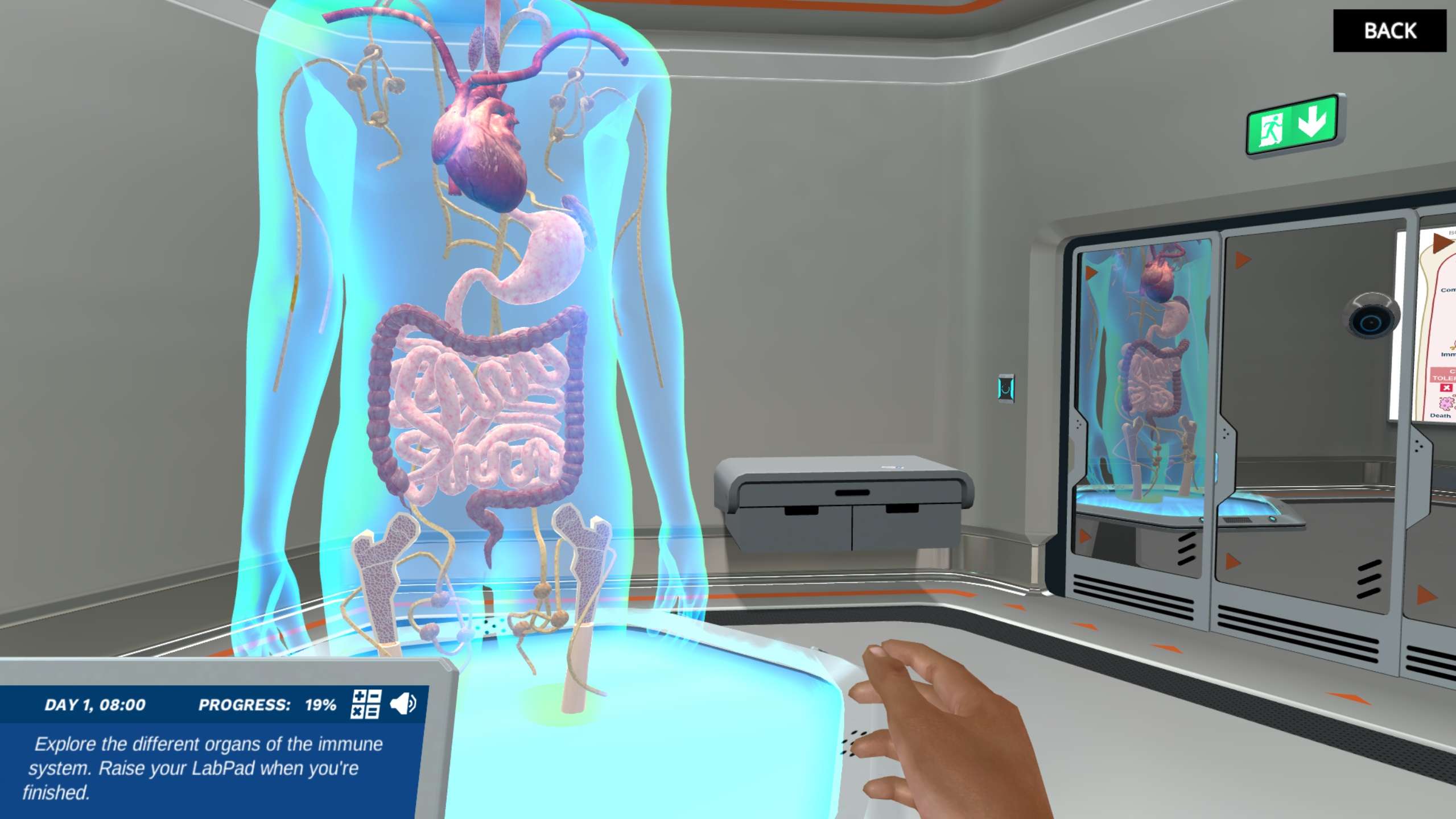Heading 1
Heading 2
Heading 3
Heading 4
Heading 5
Heading 6
Lorem ipsum dolor sit amet, consectetur adipiscing elit, sed do eiusmod tempor incididunt ut labore et dolore magna aliqua. Ut enim ad minim veniam, quis nostrud exercitation ullamco laboris nisi ut aliquip ex ea commodo consequat. Duis aute irure dolor in reprehenderit in voluptate velit esse cillum dolore eu fugiat nulla pariatur.
Block quote
Ordered list
- Item 1
- Item 2
- Item 3
Unordered list
- Item A
- Item B
- Item C
Bold text
Emphasis
Superscript
Subscript
About This Simulation
The immune system is a complex structure of cells, tissues and organs that work together to protect our bodies from infection. Dive into the complex structures and functions of those organs and cells that protect us from various pathogens every day!
Learning Objectives
- Identify the major organs of the immune system
- Classify immune cell types by their role in responses
- Explain the importance of lymphocyte clonal selection & deletion processes
About This Simulation
Lab Techniques
Related Standards
- Early Stage Bachelors Level
- EHEA Short Cycle
- EHEA First Cycle
- FHEQ 4
- FHEQ 5
- SCQF 7
- SCQF 8
- US College Year 2
- US College Year 1
- US College Year 3
- LS1.A-H1
- LS1.A-H3
Learn More About This Simulation
This short, targeted simulation is adapted from the full-length Introduction to Immunology simulation.
Have you ever wondered how your organism manages to fight millions of pathogens that are trying to infect you daily? Which organs and cells are involved in that never ending battle? During this simulation, you’ll discover this complicated network of organs and cells that create an immunological system and protect you every day. Are you ready to meet your superheroes?
Explore the major organs of the immune system
Various organs in your body are responsible for production, maturation, and control of immune cells. Even though they are not present at the site of infection, without them the immune cells wouldn’t work properly and efficiently. Sometimes non obvious organs, like the heart, can be vital for proper function of the system. Will you be able to identify all those organs and guess their function in the immunological reaction?
Classify immune cell types and their role in the system
The immune system is a complex army of cells and tissues that work together to protect your body from infection. In the next mission you’ll meet all major cells that are fighting with pathogens and protect you every day. You’ll also meet the key cells involved in immune memory and learn how the adaptive immune system helps us fight recurring infections.
For Science Programs Providing a Learning Advantage
Boost STEM Pass Rates
Boost Learning with Fun
75% of students show high engagement and improved grades with Labster
Discover Simulations That Match Your Syllabus
Easily bolster your learning objectives with relevant, interactive content
Place Students in the Shoes of Real Scientists
Practice a lab procedure or visualize theory through narrative-driven scenarios


FAQs
Find answers to frequently asked questions.
Heading 1
Heading 2
Heading 3
Heading 4
Heading 5
Heading 6
Lorem ipsum dolor sit amet, consectetur adipiscing elit, sed do eiusmod tempor incididunt ut labore et dolore magna aliqua. Ut enim ad minim veniam, quis nostrud exercitation ullamco laboris nisi ut aliquip ex ea commodo consequat. Duis aute irure dolor in reprehenderit in voluptate velit esse cillum dolore eu fugiat nulla pariatur.
Block quote
Ordered list
- Item 1
- Item 2
- Item 3
Unordered list
- Item A
- Item B
- Item C
Bold text
Emphasis
Superscript
Subscript
A Labster virtual lab is an interactive, multimedia assignment that students access right from their computers. Many Labster virtual labs prepare students for success in college by introducing foundational knowledge using multimedia visualizations that make it easier to understand complex concepts. Other Labster virtual labs prepare learners for careers in STEM labs by giving them realistic practice on lab techniques and procedures.
Labster’s virtual lab simulations are created by scientists and designed to maximize engagement and interactivity. Unlike watching a video or reading a textbook, Labster virtual labs are interactive. To make progress, students must think critically and solve a real-world problem. We believe that learning by doing makes STEM stick.
Yes, Labster is compatible with all major LMS (Learning Management Systems) including Blackboard, Canvas, D2L, Moodle, and many others. Students can access Labster like any other assignment. If your institution does not choose an LMS integration, students will log into Labster’s Course Manager once they have an account created. Your institution will decide which is the best access method.
Labster is available for purchase by instructors, faculty, and administrators at education institutions. Purchasing our starter package, Labster Explorer, can be done using a credit card if you are located in the USA, Canada, or Mexico. If you are outside of North America or are choosing a higher plan, please speak with a Labster sales representative. Compare plans.
Labster supports a wide range of STEM courses at the high school, college, and university level across fields in biology, chemistry, physics, and health sciences. You can identify topics for your courses by searching our Content Catalog.







.jpg?fm=jpg&w=700&h=400)







